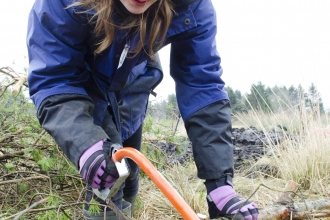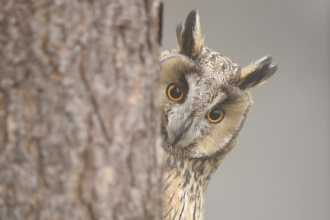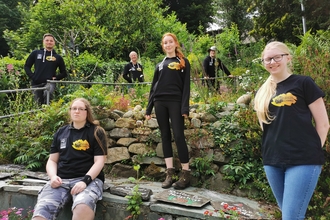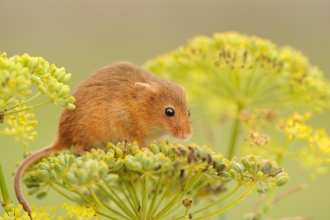Harvest mice (Micromys minutus) are a critically endangered rodent species that inhabit scrubland, wetland/reedbeds, heathland, farmland (wheat and barley fields) and tussocky grassland habitats throughout the UK. Harvest mice are notorious for creating little bundled nests weaved from long, yellow moor grass hidden in tusks of grass and denser grasses within the UK’s temperate grassland. What is more interesting is that the harvest mice can create two different types of nests used for different purposes; they can create a brooding nest (one for birthing and raising young in, which only the females create) and a solitary nest (one for a solitary harvest mouse to occupy, usually used throughout the year). Harvest mice are the only mammal to create spherical nests and make their nests high up in the ‘stalk zone’– the mice are quite small (they weigh as little as 5 grams, and are very small), and easily adapt to the tall grassy habitats they commonly inhabit. Another incredible adaptation of the harvest mouse is that they have a highly prehensile tail, which means they can use their tails like a fifth limb, gripping onto tufts of grass using their tail to support their almost arboreal lifestyle in the ‘stalk zone’ of very long grass.
A very successful harvest mouse survey!
@NWWT_AndyOCallaghan
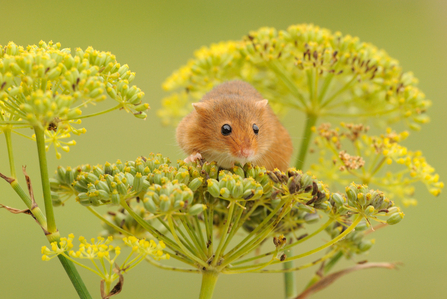
Harvest mouse © Amy Lewis
The exciting prospect of this search for harvest mice nests is that this site has not been searched for the species for a very long time, if at all, so we really didn’t expect to find any nests at all – it is not uncommon for surveys to yield no results. However, our dedicated volunteers, young and old, had the patience and initiative to pull through with performing an extensive search over the area and discovered eight nests, indeed confirming that a healthy harvest mice population inhabits the area! This information is vital towards aiding in conservation efforts for harvest mice in North Wales and contributes towards understanding what sites need the resources and effort in being taken care of and preserved for the benefit of the mice and their populations. It was extremely rewarding to have come across a harvest mouse nest myself, and I was happy to be a part of unveiling a potential harvest mouse hotspot, considering we were confident that with more time, more nests would have been discovered and collected. The healthy population of mice in the area may be due to the milder winters we have been having, which greatly helps towards improving harvest mouse survival during winter periods.
We were quite lucky to have spotted some vole nests as well, with quite a few dotted around the area in the more marshy, saturated areas of the reserve. Some of the volunteers were unfamiliar with what harvest mice nests looked like, as well as what vole nests looked like, including myself, so it was quite easy to mistake a voles' nest for a harvest mouse’s nest. However, the volunteers and coordinators alike learnt on the job to differentiate between a harvest mouse nest and a vole nest, simply by where each was found and the size of the nests as well. Vole nests are characteristically bigger than harvest mice nests, and are bundled together through rolling the grass strands and shredded grasses into a ball, whereas harvest mice meticulously weave the grasses together, typically using live grass instead of only picking the grass and letting it die, making their nests sturdier and able to hold the occupant safely – especially when considering creating brooding nests, where females will weave their nests according to potential litter size (so these brooding nests will be bigger than solitary nests) and will enable it to expand, so when her young grows, the nest will accommodate her brood until they are ready to leave. Examples of harvest mice nests are found in the pictures above and below.
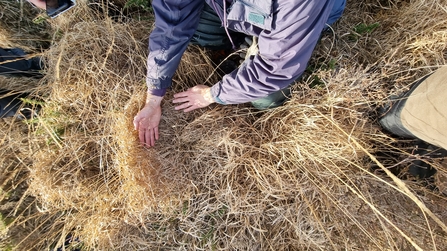
@NWWT_AndyOCallaghan
Of course, during the survey, the harvest mice and vole nests were unoccupied, as any mice nearby would hear our clumsy footsteps and vacate the area, so they wouldn’t be disturbed too much. We were considerate of the mice’s safety and made sure to check areas before we stood in them, although quite a few of us did stumble a little and were falling over the tussocks and into burrows the water voles created, which was a good laugh. We also discovered that within the abandoned nests, there were some cheeky snails hibernating in them, making the most of what other animals have built and left behind – an amazing example of how different species interact, indirectly benefiting another species' population.
Our local encounter was in good timing, since we could also contribute to the national harvest mouse survey, led by the Mammal Society, where people from all over the country pull together to search for signs of harvest mice / or equally their absence. This effectively contributes to the data collection of the harvest mice’s population status and distribution, as well as how well they are coping this winter. If you are interested in getting involved with the National Harvest Mouse Survey, just follow the link, Harvest Mouse Survey – The Mammal Society . We hope to continue surveying more areas around Ynys Môn, with historical records of harvest mice populations of areas that have been left unexamined for harvest mice for a very long time. Harvest mice populations are disappearing around Wales, and much of the UK, at an alarming rate – especially due to more intensive farming methods, habitat fragmentation and habitat destruction – which is why it is so important to monitor their populations and understand what affects their survival and conservation.
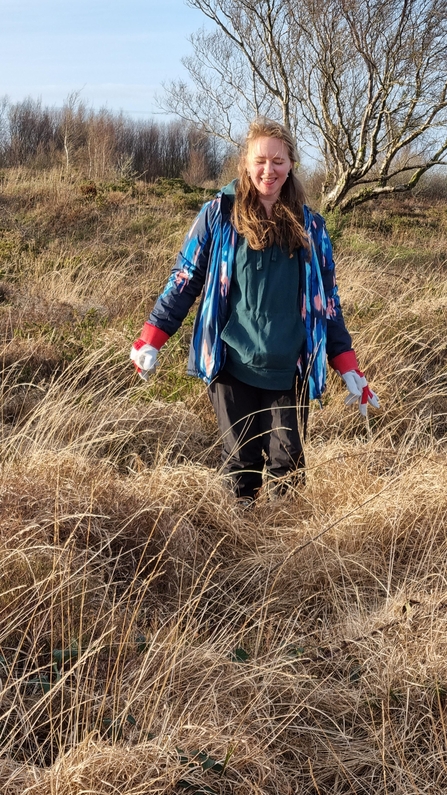
Volunteer © NWWT AndyOCallaghan
Amber, Mon Gwyrdd volunteer and author of this blog out and about on the harvest mouse survey.






